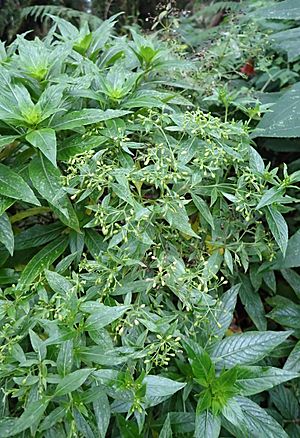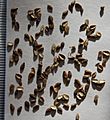Phyllis nobla facts for kids
Quick facts for kids Phyllis nobla |
|
|---|---|
 |
|
| Scientific classification |
Phyllis nobla is a small plant that is part of the Rubiaceae family. It's a type of subshrub, which means it's a plant that has woody stems at its base but softer, non-woody stems higher up, like a small bush. This plant can be either smooth (called glabrous) or covered in fine hairs (called pubescent).
What it Looks Like
The leaves of Phyllis nobla are usually shaped like a spearhead (lanceolate) or an egg (ovate). They have smooth edges and come to a sharp point.
The flowers are small and whitish. They grow in loose clusters called panicles. These flower clusters can be found at the very end of the stems or where the leaves meet the stem. When the plant produces fruit, the small stalks holding the fruits hang downwards.
Where it Grows
Phyllis nobla is found on islands in the Atlantic Ocean, specifically in the Madeira and Canary Islands.
Madeira Islands
This plant grows in many places in Madeira, from the coast all the way up to 1800 meters high. You can find it on cliffs, rocky areas, and even on the walls next to levadas (which are special water channels used for irrigation). While it's common in Madeira, it's rarer on the island of Porto Santo. There, it's mostly found on the northern coast near Fonte d'Areia, on Pico do Facho, and on Ilheu de Baiyo. It also grows on Deserta Grande Island and the eastern side of Bugio.
Canary Islands
In the Canary Islands, Phyllis nobla prefers certain areas:
- Tenerife: It's very common on cliffs and banks in the Laurel forest areas, especially from Las Mercedes to Vueltas de Taganana and Aguamansa. It grows at heights between 600 and 1200 meters.
- La Palma: You can find it in places like Cumbre Nueva, El Paso, and Barlovento.
- La Gomera: It grows in areas such as Monte del Cedro, Arure, and Chorros de Epina.
- El Hierro: It's found in the forest regions of El Golfo and Valverde (Ventejís).
- Gran Canaria: It's rare here, but can be found on pine forest cliffs in Pinar de Tamadaba (around 1000 meters high) and near Presa de los Pérez.
Gallery
See also
 In Spanish: Phyllis nobla para niños
In Spanish: Phyllis nobla para niños




